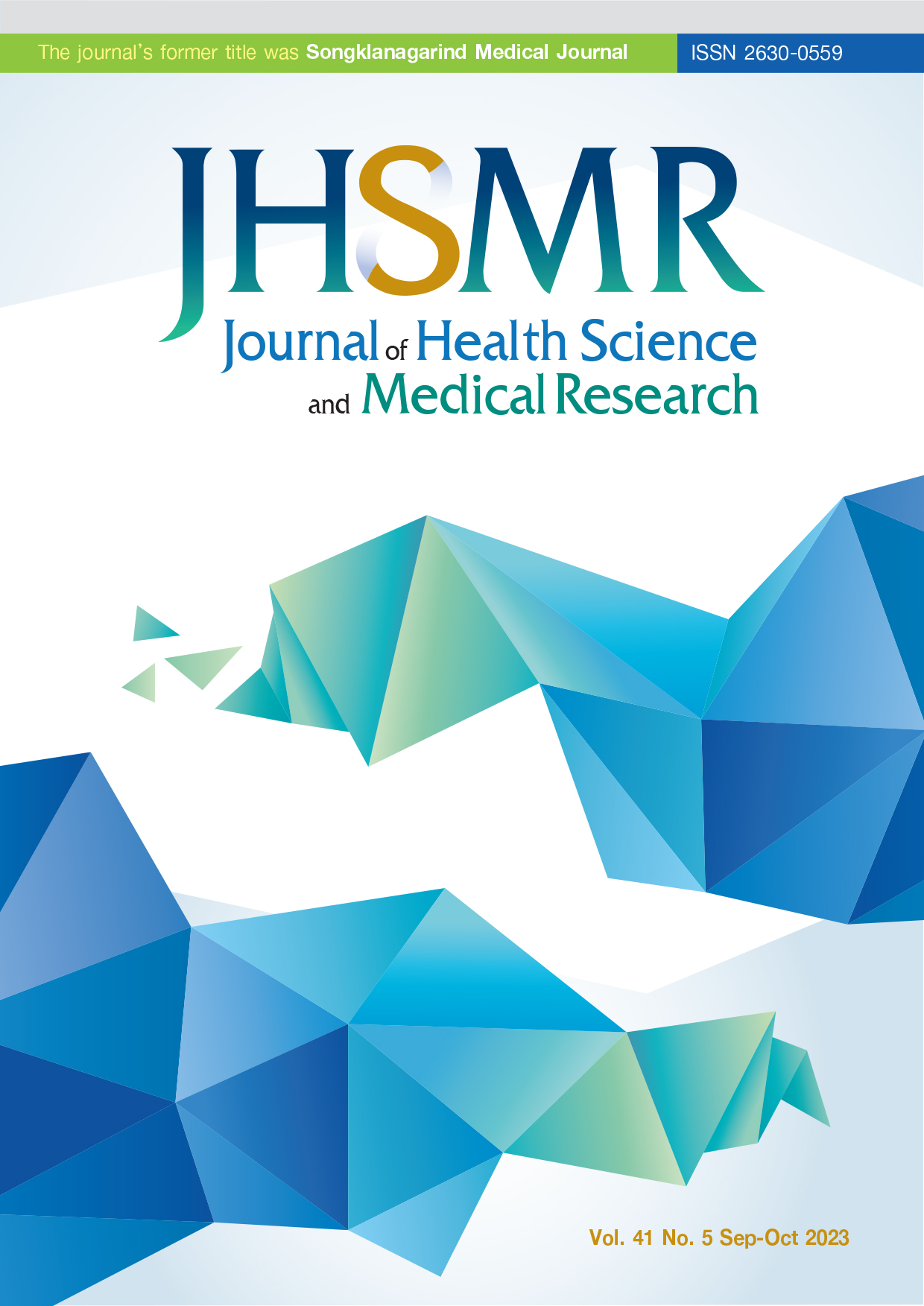Predictors of Nonadherence to Planned Coronary Angiography: A Retrospective Analysis
DOI:
https://doi.org/10.31584/jhsmr.2023949Keywords:
nonadherence, planned coronary angiography, predictorsAbstract
Objective: This study aimed to determine the predictive power of patient-related factors, socio-economic factors, condition-related factors, treatment-related factors, and health care system-related factors for nonadherence to planned coronary angiography (CAG).
Material and Methods: A retrospective analysis was conducted on electronic medical records (EMR) of 665 patients appointed for elective CAG at Naradhiwas Rajanagarindra Heart Center from January 2018 to December 2019. One hundred and thirty-three patients with nonadherence to planned CAG were assigned to the study group; the control group consisted of 532 patients with adherence to planned CAG.
Results: The retrospective data analysis revealed that divorced or widowed status (OR=3.07; 95% CI 1.54, 6.12), cerebrovascular disease comorbidity (OR=4.37; 95% CI 1.74, 10.96), prescribed diuretics (OR=2.24; 95% CI 1.26, 3.97), CAG wait time three months or longer (OR=3.34; 95% CI 1.46, 7.64) and history of parental cardiovascular disease or death from heart disease (OR=0.12; 95% CI 0.01, 0.95) were co-predictors of nonadherence to planned CAG. Socioeconomic- related factors had no predictive power for planned CAG nonadherence.
Conclusion: The findings of this study may contribute to the improvement of nursing service by screening groups at high risk of nonadherence and developing appropriate interventions aimed at increasing adherence to planned CAG as well the rate of positive health outcomes.
References
Lee DW, Stouffer GA. Diagnostic coronary angiography. In Stouffer GA, Runge MS, Rossi JS, Netter FH, editor. Netter’s cardiology. 3rd ed. Dutch: Elsevier; 2019;p.81-91.
Knuuti J, Wijns W, Saraste A, Capodanno D, Barbato E, Funck-Brentano C, et al. 2019 ESC Guidelines for the diagnosis and management of chronic coronary syndromes: The Task Force for the diagnosis and management of chronic coronary syndromes of the European Society of Cardiology (ESC). Eur Heart J 2020;41:407-7.
Leopold JA, Faxon DP. Diagnostic cardiac catheterization and coronary angiography. In: Jameson JL, Fauci AS, Kasper DL, Hauser SL, Longo DL, Loscalzo J, editor. Harrison’s Principles of Internal Medicine. 20th ed. New York: McGraw Hill; 2019.
The Heart Association of Thailand under the Royal Patronage. Thai Acute Coronary Syndromes Guidelines 2020. Bangkok: Nexstep; 2020.
Shea MJ, Cascino T. Cardiac catheterization and coronary angiography. Merck manuals [homepage on the Internet]. New Jersey: Merck; 2019 [cited 2022 Jun 5]. Available from: https:// www.merckmanuals.com/
Qanitha A, Uiterwaal CS, Henriques JP, Mappangara I, Amir M, Saing SG, et al. Adherence to guideline recommendations for coronary angiography in a poor south-east Asian setting: impact on short-and medium-term clinical outcomes. Sci Rep 2019;9:1-9.
Keskin K, Cetinkal G, Ser OS, Sigirci S, Gurdal A, Kilickesmez K. The rate of coronary angiography refusal in older patients with non-ST elevation acute coronary syndrome and its impact on all-cause mortality. Med Bull Sisli Etfal Hosp 2021;55:532-7.
Naradhiwas Rajanagarindra Heart Center, Songklanagarind Hospital. Data of cancel-ing appointments for invasive procedures. Songkhla: Songklanagarind Hospital; 2019.
Feldman L, Steg PG, Amsallem M, Puymirat E, Sorbets E, Elbaz M, et al. Editor’s Choice-Medically managed patients with non-ST-elevation acute myocardial infarction have heterogeneous outcomes, based on performance of angiography and extent of coronary artery disease. Eur Heart J 2017;6:262–71.
World Health Organization. Adherence to long-term therapies: evidence for action. Geneva: WHO; 2003.
Mirzaei A, Carter SR, Patanwala AE, Schneider CR. Missing data in surveys: key concepts, approaches, and applications. Res Social Adm Pharm 2022;18:2308-16.
National Health Security Office. Guide for users of health insurance rights [homepage on the Internet]. Bangkok: National Health Security Office; 2021 [cited 2022 Jun 5]. Available from: https://www.nhso.go.th/
Brieger D, Chow C, Gullick J, Hyun K, D’souza M, Briffa T, et al. Improving patient adherence to secondary prevention medications 6 months after an acute coronary syndrome: Observational cohort study. Int Med J 2018;48:541–9.
Gonarkar SB, Dhande PP. Medication adherence and its determinants in myocardial infarction patients: an Indian scenario. J Clin Prev Cardiol 2016;5:2.
Librero J, Sanfelix-Gimeno G, Peiro S. Medication adherence patterns after hospitalization for coronary heart disease. A population-based study using electronic records and group-based trajectory models. Plos One 2016;11:e0161381. doi: 10.1371/journal.pone.0161381.
Heidenreich PA, Bozkurt B, Aguilar D, Allen LA, Byun JJ, Colvin MM, et al. 2022 AHA/ACC/HFSA guideline for the management of heart failure: A report of the American College of Cardiology/American Heart Association Joint Committee on Clinical Practice Guidelines. Circulation 2022;145:e876-94. doi: 10.1161/CIR.0000000000001062.
Bahremand M, Ahmadinejad T, Jenab Y, Hoseini SK, Lotfi-Tokaldany M, Jalali A. Decision making in Ischemic cardiomyopathy: variability in physicians’ approaches and patients’ adherence. Revista Latinoamericana de Hipertension 2019;14:251-9.
Doshmangir L, Pourasghar F, Sharghi R, Rezapour R, Gordeev VS. Developing a prioritisation framework for patients in need of coronary artery angiography. BMC Public Health 2021;21:1-8.
Herwig A, Dehnen D, Weltermann B. Patient factors driving overuse of cardiac catheterization: a qualitative study with 25 participants from two German teaching practices. Bri Med J Open 2019;9:e024600.
Hussain S, Jamal SZ, Qadir F. Medication adherence in post myocardial infarction patients. J Ayub Med Coll Abbottabad 2018;30:552–7.
Pietrzykowski L, Michalski P, Kosobucka A, Kasprzak M, Fabiszak T, Stolarek W, et al. Medication adherence and its determinants in patients after myocardial infarction. Sci Rep 2020;10:1-11.
Salari A, Rouhi BL, Ashouri A, Moaddab F, Zaersabet F, Nourisaeed A. Medication adherence and its related factors in patients undergoing coronary artery angioplasty. J Car Sci 2018;7:213–8.
McGuinness MB, Kasza J, Guymer RH. Is There a Case for Case-Control Studies in the Exploration of Retrospective Data Sets? JAMA Ophthalmol 2021;139:309-10.
Downloads
Published
How to Cite
Issue
Section
License

This work is licensed under a Creative Commons Attribution-NonCommercial-NoDerivatives 4.0 International License.
























